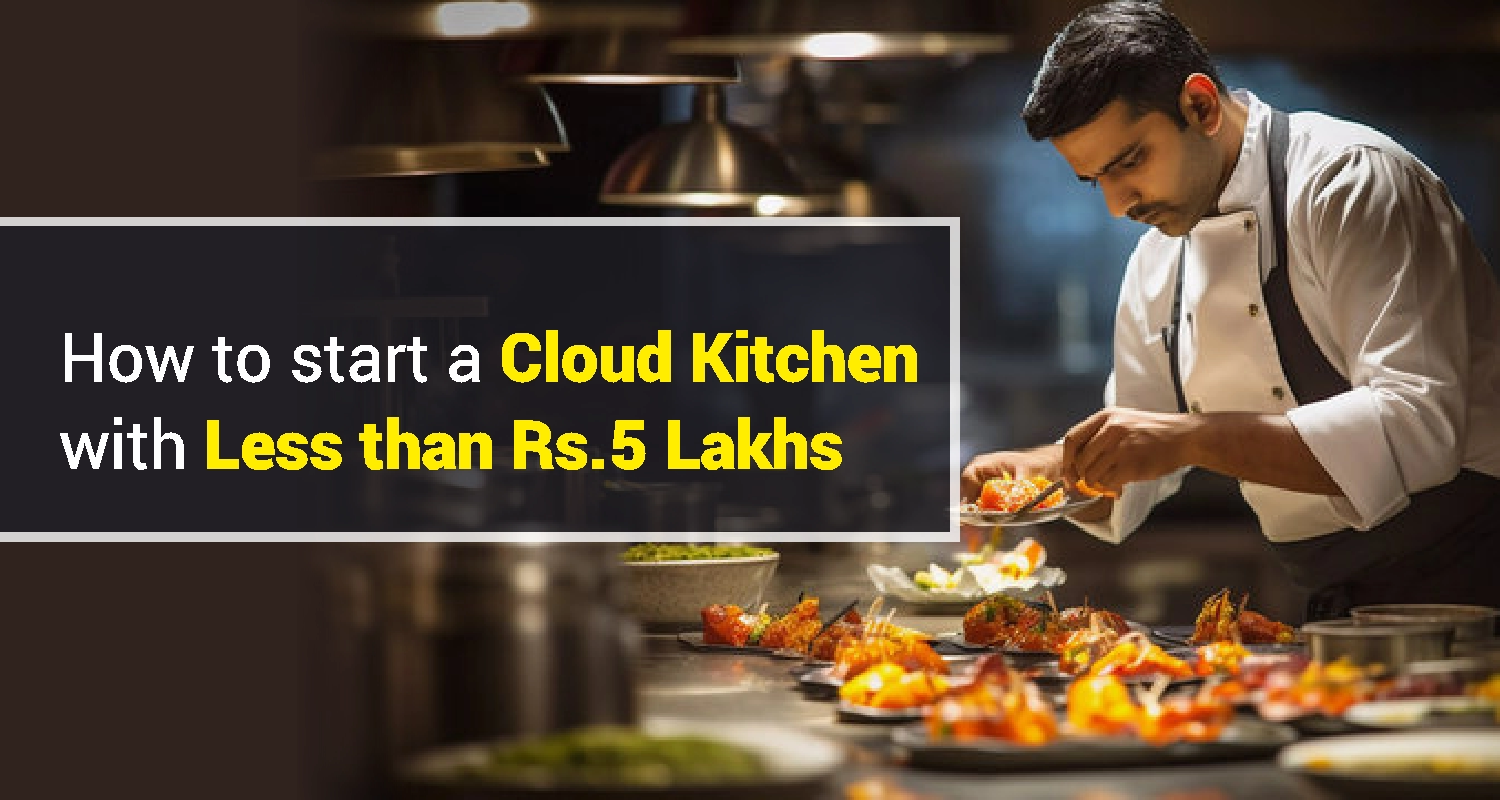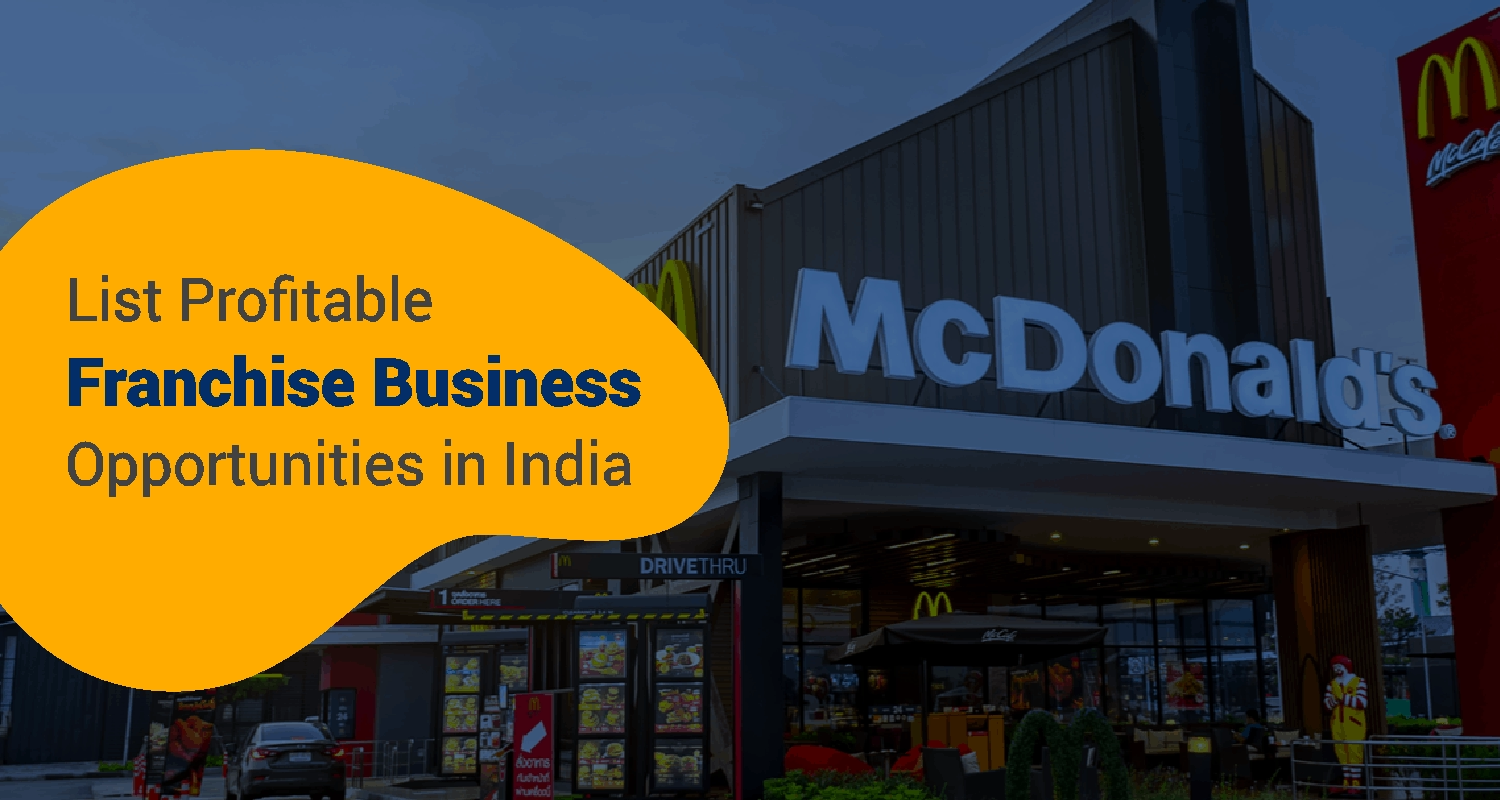How to Start a Cloud Kitchen With Less than ₹5 Lakhs

Gone are the days when dining out was the only way to escape everyday home-cooked meals. Now, food aggregators like Zomato and Swiggy run 24/7, delivering fresh food right to your doorstep. This has become a common sight and changed the way people enjoy food. For food entrepreneurs, small restaurant owners, and those in the industry, the rise of online food ordering is hard to miss. In fact, the number of online food delivery users is expected to reach 2.9 million by 2026. Now, imagine a whole sector designed for this booming trend—cloud kitchens. If you're a foodie, a food entrepreneur, a food truck owner, or someone looking to know how to open a cloud kitchen for under Rs.5 lakhs, this article is for you.
What is a Cloud Kitchen?
Before proceeding with how to start a cloud kitchen from home, let’s understand the cloud kitchen model. A cloud kitchen is a restaurant that only takes orders online, without any dine-in facility. Also called dark kitchens, ghost kitchens, or virtual restaurants, these setups focus solely on preparing and delivering meals. They might have their own website or app for taking orders or use food delivery platforms.
Since most businesses come from these platforms, having Point of Sales (POS) software that handles orders from various sources is crucial. It saves you the trouble of manually tracking and calculating orders at the end of the day. Cloud kitchens prioritize cooking and delivering food straight to your doorstep, making it a convenient option for customers looking for tasty meals without leaving home.
The four main types of cloud kitchens are-
Independent Cloud KitchenAn independent cloud kitchen runs without storefronts or signage, focusing only on preparing and delivering food. By eliminating the need for a customer-facing space, it slashes expenses on rent, décor, and front-of-house staff. Success here hinges on managing orders well and keeping food quality high during delivery.
Branded Cloud KitchenA branded cloud kitchen uses a specific name or theme, even without a physical storefront. It often runs several virtual brands from one kitchen, each with a unique menu and marketing strategy. The idea is to attract a wider audience by catering to different tastes and making the most of the kitchen’s resources.
Shared Cloud KitchenIn a shared cloud kitchen, several food businesses work from the same kitchen space. While each business has its own cooking area, they share common spaces like storage and delivery logistics. This setup helps reduce costs for each brand, making it a great choice for startups and small businesses looking to cut expenses.
Kitchen Incubator Cloud KitchenA kitchen incubator cloud kitchen offers a fully equipped space along with support services for budding food entrepreneurs. Beyond just providing a kitchen, it offers mentorship, marketing help, and guidance on operations. This model is perfect for newcomers to the food industry who need a structured environment to test and grow their concepts.
Sapna aapka. Business Loan Humara.
Apply NowHow does cloud kitchen work?
You place an order through a food delivery platform or directly on the cloud kitchen's app or website. The kitchen receives your order instantly through their Point of Sales (POS) software. The staff then gets to work, preparing the meal as soon as the order comes in.
Once the food is ready, whether it's from a restaurant or a tiffin service, a delivery partner is notified and picks up the freshly prepared meal from the kitchen. The delivery person then heads straight to your location, ensuring the food reaches you hot and ready to enjoy. From receiving the order to cooking and delivering, the whole process is designed to be quick and efficient, bringing tasty meals right to your doorstep without any dine-in hassle.
How to set up a cloud kitchen?
1. Market and Business Research:
Starting a cloud kitchen is a great way to make money while treating customers to tasty meals. But before jumping in, start with identifying your target audience and what they want. Do they care more about fast delivery, affordable meals, or a gourmet experience? Matching your offerings to their needs is crucial. Take a look at other cloud kitchens in your area. Spotting their strengths and weaknesses helps you carve out a unique space in the market. The cloud kitchen industry is growing fast and offers good profit margins, usually around 20% to 30%, thanks to lower overhead costs than traditional restaurants. Research pays off, helping you start strong and stand out.
2. List the required equipment:
The list of cloud kitchen requirements begins with the proper setup. Choosing the right cloud kitchen equipment is vital to setting up a cloud kitchen. The costs, however, depend on the cuisine you plan to offer. A basic setup, including an Indian burner, a Chinese burner, and a stainless-steel table, usually costs around Rs.60,000 to Rs.70,000. To cut costs, consider second-hand options.
If you're aiming for specialized cuisines like pizzas or baked goods. Ovens can range from Rs.12,000 to several lakhs, depending on the size and features. Similarly, tandoors start at around Rs.10,000 and can go higher based on the specifications. So, keeping the budget of Rs.5 lakhs cost allocations, list all the equipment you'll need and research pricing trends on different platforms for updated recommendations. This will help you plan your budget more effectively.
3. Kitchen Location:
When starting a cloud kitchen, finding the right location and property is essential. You don't need a prime real estate spot or a high-traffic area. Without a storefront, you can easily set up in a space as small as 250–300 square feet. This makes the initial costs much lower compared to traditional restaurants. Since we are looking at a budget of Rs.5 lakhs, setting up a cloud kitchen at home is a wise choice. Even a residential area works well. It allows you to cook and deliver right from home, the back of a market, or even an empty parking lot.
4. Rent and Lease Terms:
If you plan to opt for a location other than your house, prioritize cost-efficiency over visibility. In metro cities like Bengaluru and Mumbai, renting a 300-600 sq ft space costs between Rs.20,000 and Rs.50,000 per month. You'll also need a security deposit of Rs.1,00,000 to Rs.2,00,000. If you choose the upper floors of commercial buildings or less prominent areas, you can save a lot since visibility isn't crucial for cloud kitchens. In tier II and III cities, you can rent spaces of 100-200 sq ft for Rs.8,000 to Rs.10,000 a month, with security deposits ranging from Rs.50,000 to Rs.1,00,000.
5. Cloud kitchen license:
Licensing is crucial when starting a restaurant. Here are some licenses you’ll need within the first month for a smooth start:
- FSSAI License: This is mandatory for all food businesses; it ensures your kitchen meets safety and hygiene standards. It costs about Rs.2,000, including agent fees.
- Trademark Registration: Protect your brand by registering your kitchen’s name or logo. This costs roughly Rs.6,000, factoring in attorney fees.
- Municipal Trade License: This is required to legalize your operations in the locality. It costs around Rs.1,000.
- Gas Connection: To use gas in the kitchen, you will need a gas connection and the necessary safety measures. These will cost around Rs.5,000.
- Electricity Connection: Power your kitchen by securing an electricity connection, with deposits of around Rs.20,000.
- Fire NOC: Since kitchens involve fire, get a No Objection Certificate from the fire department for Rs.1,000.
- Udhyam registration: Cloud kitchens need Udhyam registration, which provides several advantages to micro, small, and medium enterprises (MSMEs). These benefits include access to government schemes, low-interest loans, and simplified processes for obtaining licenses.
Also, obtain a Gumasta Dhara (Shop and Establishment License). In India, every cloud kitchen, whether a food truck or fine dining, must comply with the Shop and Establishment Act, which involves maintaining labor records, attendance, salaries, and more. You can hire an agency to handle these permits, as the process can be tedious.
6. Selecting the platform:
After choosing your venue, it’s time to pick the right technology for taking orders. Many third-party websites can handle online orders for you. However, these platforms usually take 18 to 30% of your sales for each order. Some FoodTech companies might also charge a one-time integration fee. You can also build your own website and find various website developers who can create a well-optimized site.
Having a website with online ordering is crucial since a cloud restaurant relies entirely on its online presence to attract customers. When choosing a platform, make sure it enhances your efficiency in managing clients and processing orders. It's also important that the service allows customers to track their orders in real-time.
7. Sourcing raw materials:
The cloud kitchen startup cost also includes the cost of raw materials. Every ingredient needs to be sourced fresh and such that its low shelf life doesn’t lead to wastage. When starting out, it's best to begin small. Buy raw materials for just 2-3 days of business. A budget of around Rs. 20,000 for these materials is a good starting point. This way, you can manage changes in order volume and reduce waste, especially since sales can initially be unpredictable.
As you move forward, keep tightening your purchasing strategy. Consider using software to make record-keeping easier. If you work with a third-party food delivery platform, remember they pay weekly. Plan your raw material needs before those payments come in. Always look for ways to cut costs. Negotiate with suppliers for the best prices. Even small discounts can add up to big savings over time. Keep an eye out for savings and create a culture of efficiency in your cloud kitchen.
8. Packaging:
The missing dining experience in the cloud kitchen is replaced by the delivery experience. Thus, keeping your packaging game on point is necessary to retain the order numbers. Investing in packaging materials, like containers, stickers, and custom sachets, can cost between Rs.40,000 and Rs.60,000, depending on quality and quantity.
Packaging is more than just a container; it's customers' first physical connection with your brand. It sets the tone for their experience before they even taste the food, creating anticipation and stirring emotions. Good packaging not only keeps the food secure but also tells a story, enhancing your brand's presence. Look to add some seasoning or sauce that can give different levels of preferred flavors. The goal is to make your packaging memorable, encouraging customers to return.
9. Staff Recruitment:
Though initially, before the brand spreads wide, you may not require helping hands in the kitchen. But once the brand blooms, you will need at least two chefs and two helpers to look after everything other than cooking. A chef's average salary can be estimated at around Rs.14,000 to Rs.15,000, while helpers and other staff earn between Rs.6,000 to Rs.8,000, depending on their roles. You'll also need two delivery personnel and one at the counter to handle online and phone orders. For the delivery part, you can partner with third-party delivery services that charge per order.
10. Marketing and promotion:
Since your orders come solely from online channels, you should set aside some marketing budget. Online marketing can give your cloud kitchen a big boost. Start by listing your restaurant on popular review platforms like Zomato, Tripadvisor, and Burrp, and encourage your regular customers to leave positive reviews. You can also use Facebook to promote exclusive deals and discounts, which can help attract more orders and grow your customer base. Curate a plan focusing on promotion, brand recall, and reminder ads to ensure your brand keeps circulating.
Cloud kitchen companies in India require an initial investment of at least Rs.3 lakhs to Rs.5 lakhs considering the set-up begins at home and cost-cutting is practiced wherever possible without compromising on the quality of food.
Bottomline
Cloud kitchen (India) is the best example of a business model that has leveraged the advent of technology, the internet, and the demand for convenience in the best possible manner. Starting a cloud kitchen is a great way to tap into today's growing food industry. By following the steps in this guide, you can build a strong foundation for a successful and profitable business. However, setting up a cloud kitchen isn't without its challenges, especially when it comes to business registration and legal compliance. These complexities can be tricky to manage on your own. That's why getting the proper support is essential to ensure everything is set up correctly and your cloud kitchen runs smoothly within legal boundaries.
FAQs
Q1. What is a cloud kitchen franchise?Ans. The cloud kitchen franchise is a business model similar to the normal cloud kitchen. The only difference is that the franchiser’s online platform is used for receiving orders. It offers the flexibility to run multiple brands from one kitchen, reducing overhead costs like rent and staffing.
Q2. How to open a cloud kitchen on Zomato?Ans. Zomato is a top online food delivery platform in India. Partnering with it gives you access to a large customer base and makes delivery logistics easy:
- Zomato Registration: Go to the "Partner with Us" section on Zomato's website. Fill out the form with your business details, menu, and location.
- Documentation: Submit documents like your FSSAI license, business registration, bank account details, and menu.
- Zomato Onboarding: Once approved, Zomato's team will guide you through onboarding, including training, setting up your online menu, and optimizing your delivery listings.
Ans. Cloud kitchens usually see profit margins of 20%-25%. But it all depends on your order volume. If you manage 25-50 orders daily, each costing Rs.200-250, you could earn Rs.2 lakhs to Rs.4 lakhs a month. That means your average monthly profit could be around Rs.50,000 to Rs.90,000 after factoring in the costs and third-party platform fees, if applicable.
Sapna aapka. Business Loan Humara.
Apply NowDisclaimer: The information contained in this post is for general information purposes only. IIFL Finance Limited (including its associates and affiliates) ("the Company") assumes no liability or responsibility for any errors or omissions in the contents of this post and under no circumstances shall the Company be liable for any damage, loss, injury or disappointment etc. suffered by any reader. All information in this post is provided "as is", with no guarantee of completeness, accuracy, timeliness or of the results etc. obtained from the use of this information, and without warranty of any kind, express or implied, including, but not limited to warranties of performance, merchantability and fitness for a particular purpose. Given the changing nature of laws, rules and regulations, there may be delays, omissions or inaccuracies in the information contained in this post. The information on this post is provided with the understanding that the Company is not herein engaged in rendering legal, accounting, tax, or other professional advice and services. As such, it should not be used as a substitute for consultation with professional accounting, tax, legal or other competent advisers. This post may contain views and opinions which are those of the authors and do not necessarily reflect the official policy or position of any other agency or organization. This post may also contain links to external websites that are not provided or maintained by or in any way affiliated with the Company and the Company does not guarantee the accuracy, relevance, timeliness, or completeness of any information on these external websites. Any/ all (Gold/ Personal/ Business) loan product specifications and information that maybe stated in this post are subject to change from time to time, readers are advised to reach out to the Company for current specifications of the said (Gold/ Personal/ Business) loan.



